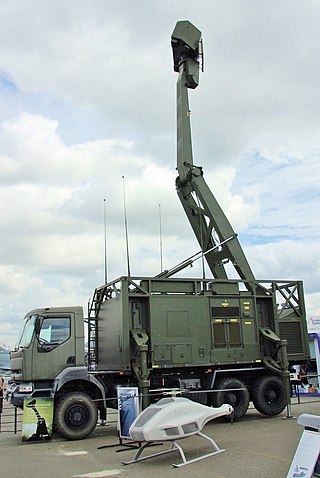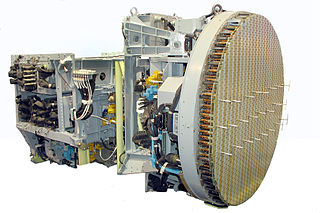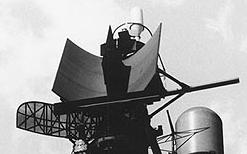
An active electronically scanned array (AESA) is a type of phased array antenna, which is a computer-controlled array antenna in which the beam of radio waves can be electronically steered to point in different directions without moving the antenna. In the AESA, each antenna element is connected to a small solid-state transmit/receive module (TRM) under the control of a computer, which performs the functions of a transmitter and/or receiver for the antenna. This contrasts with a passive electronically scanned array (PESA), in which all the antenna elements are connected to a single transmitter and/or receiver through phase shifters under the control of the computer. AESA's main use is in radar, and these are known as active phased array radar (APAR).

The AN/APG-66 radar is a solid state medium range pulse-Doppler planar array radar originally designed by the Westinghouse Electric Corporation for use in the F-16 Fighting Falcon. This radar was employed in all domestic and export versions of the F-16 A/B models throughout the production. Subsequent upgrades have been installed in many varying aircraft types, including the U.S. Customs and Border Protection's C-550 Cessna Citation, US Navy P-3 Orion, and Piper PA-42 Cheyenne II's, as well as the Small Aerostat Surveillance System (SASS). Primary air-combat mode is look-down. In that mode, the AN/APG-66 can detect a fighter-size plane at a range of 34.5 Nautical miles. Four modes are available in air-to-air combat. In dogfight mode, the radar scans a 20 degrees x 20 degrees field. In high-g maneuvers, it scans a 40 degrees x10 degrees pattern. The radar system consists of the following line-replaceable units:
Monopulse radar is a radar system that uses additional encoding of the radio signal to provide accurate directional information. The name refers to its ability to extract range and direction from a single signal pulse.
The AN/APG-76 radar is a pulse Doppler Ku band multi-mode radar developed and manufactured by Northrop Grumman.

The AN/SPS-48 is a US naval electronically scanned array, air search three-dimensional radar system manufactured by ITT Exelis and deployed in the 1960s as the primary air search sensor for anti-aircraft warships. The deployment of the AN/SPY-1 and the end of the Cold War led to the decommissioning of many such ships, and many of these vessel's AN/SPS-48 sets were reused on aircraft carriers and amphibious ships where it is used to direct targets for air defense systems such as the Sea Sparrow and RIM-116 SAM missiles. Existing sets are being modernized under the ROAR program to AN/SPS-48G standard for better reliability and usability.

The AN/SPS-49 is a United States Navy two-dimensional, long range air search radar built by Raytheon that can provide contact bearing and range. It is a primary air-search radar for numerous ships in the U.S. fleet and in Spain, Poland, Taiwan aboard Oliver Hazard Perry-class frigates, Canada on its Halifax-class frigate and New Zealand on its Anzac-class frigates. It formerly served in a complementary role aboard Aegis cruisers with the AN/SPY-1 but the systems are currently being removed during routine upgrade with no replacement.

The Saab Giraffe Radar is a family of land and naval two- or three-dimensional G/H-band passive electronically scanned array radar-based surveillance and air defense command and control systems. It is tailored for operations with medium- and Short Range Air Defense (SHORAD) missile or gun systems, or for use as gap-fillers in a larger air defense system.

The AN/FPS-16 is a highly accurate ground-based monopulse single object tracking radar (SOTR), used extensively by the NASA manned space program, the U.S. Air Force and the U.S. Army. The accuracy of Radar Set AN/FPS-16 is such that the position data obtained from point-source targets has azimuth and elevation angular errors of less than 0.1 milliradian and range errors of less than 5 yards (5 m) with a signal-to-noise ratio of 20 decibels or greater.

The Zhuk are a family of Russian all-weather multimode airborne radars developed by NIIR Phazotron for multi-role combat aircraft such as the MiG-29 and the Su-27. The PESA versions were also known as the Sokol.

The Bars (Leopard) is a family of Russian all-weather multimode airborne radars developed by the Tikhomirov Scientific Research Institute of Instrument Design for multi-role combat aircraft such as the Su-27 and the MiG-29.

The central acquisition radar (3D-CAR) is a 3D radar developed by DRDO for use with Akash SAM capable of tracking 150 targets.
Moving target indication (MTI) is a mode of operation of a radar to discriminate a target against the clutter. It describes a variety of techniques used for finding moving objects, like an aircraft, and filter out unmoving ones, like hills or trees. It contrasts with the modern stationary target indication (STI) technique, which uses details of the signal to directly determine the mechanical properties of the reflecting objects and thereby find targets whether they are moving or not.
The AN/APY-10 is an American multifunction radar developed for the U.S. Navy's Boeing P-8 Poseidon maritime patrol and surveillance aircraft. AN/APY-10 is the latest descendant of a radar family originally developed by Texas Instruments, and now Raytheon after it acquired the radar business of TI, for Lockheed P-3 Orion, the predecessor of P-8.

The AN/SPY-1 is a United States Navy 3D radar system manufactured by Lockheed Martin. The array is a passive electronically scanned system and a key component of the Aegis Combat System. The system is computer controlled and uses four complementary antennas to provide 360-degree coverage. The system was first installed in 1973 on USS Norton Sound and entered active service in 1983 as the SPY-1A on USS Ticonderoga. The -1A was installed on ships up to CG-58, with the -1B upgrade first installed on USS Princeton in 1986. The upgraded -1B(V) was retrofitted to existing ships from CG-59 up to the last, USS Port Royal.
Radar envelope is a critical Measure of Performance (MOP) identified in the Test and Evaluation Master Plan (TEMP). This is the volume of space where a radar system is required to reliably detect an object with a specific size and speed. This is one of the requirements that must be evaluated as part of the acceptance testing process.
High Resolution Wide Swath (HRWS) imaging is an important branch in Synthetic aperture radar (SAR) imaging, a remote sensing technique capable of providing high resolution images independent of weather conditions and sunlight illumination. This makes SAR very attractive for the systematic observation of dynamic processes on the Earth's surface, which is useful for environmental monitoring, earth resource mapping and military systems.
The AR-320 is a 3D early warning radar developed by the UK's Plessey in partnership with US-based ITT-Gilfillan. The system combined the receiver electronics, computer systems and displays of the earlier Plessey AR-3D with a Gilfillan-developed transmitter and planar array antenna from their S320 series. The main advantage over the AR-3D was the ability to shift frequencies to provide a level of frequency agility and thus improve its resistance to jamming.

OPS-11 is a two-dimensional radar manufactured by Mitsubishi Electric. It is installed as an anti-aircraft search radar on the Maritime Self-Defense Force's escort ship, and it will be the first model originally developed by Japan after World War II for this purpose. Variations include OPS-11B and OPS-11C.

AN/SPS-8 is a two-dimensional radar manufactured by General Electric. It was used by the US Navy as a height finding radar after World War II, and was equipped aboard naval ships during the Cold War. Variants include AN/SPS-8A, AN-SPS/8B, AN/SPS-8C and AN/SPS-8D After modernization, it was redesignated as AN/SPS-30.

AN/SPS-39 is a three-dimensional radar was manufactured by Hughes Aircraft Company. It was used by the US Navy as a parabolic-cylinder reflector antenna after World War II, and was equipped aboard naval ships during the Cold War. It was mass-produced based on AN/SPS-26, and was also the first 3D radar deployed by the US Navy in the fleet. It later evolved into an improved AN/SPS-52.













